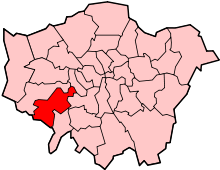Hampton, London
| Hampton | |
|---|---|
|
The Thames at Hampton St Mary's Church by Pier, Ferry, Garrick's Shakespeare Temple, Garrick House and public riverside | |
 Hampton Hampton shown within Greater London | |
| Area | 8.83 km2 (3.41 sq mi) |
| Population | 19,372 (2011 census)[1] |
| • Density | 2,194/km2 (5,680/sq mi) |
| OS grid reference | TQ135705 |
| London borough | |
| Ceremonial county | Greater London |
| Region | |
| Country | England |
| Sovereign state | United Kingdom |
| Post town | HAMPTON |
| Postcode district | TW12 |
| Dialling code | 020 |
| Police | Metropolitan |
| Fire | London |
| Ambulance | London |
| EU Parliament | London |
| UK Parliament | |
| London Assembly | |
Hampton is a suburban area on the north bank of the River Thames, in the London Borough of Richmond upon Thames, England,[n 1] which includes Hampton Court Palace. Hampton is served by two railway stations, including one immediately south of Hampton Court Bridge in East Molesey.
Hampton adjoins Bushy Park on two sides and is west of Hampton Wick and Kingston upon Thames. There are long strips of public riverside in Hampton and the Hampton Heated Open Air Pool is one of the few such swimming pools in Greater London. The riverside, on the reach above Molesey Lock, has residential islands and grand or decorative buildings including Garrick's House and the Temple to Shakespeare; also on the river is the Astoria Houseboat recording studio. Hampton Ferry provides access across the Thames to the main park of Molesey and the Thames Path National Trail.
The most common type of housing in the north of the district is terraced homes; in the south is it semi-detached. At the western edge of London, many workers commute to adjacent counties, or to Central London; education, health and social work, retail, transport and catering businesses are also significant local employers.
History
The Anglo-Saxon parish of Hampton converted to secular use in the 19th century included present-day Hampton, Hampton Hill, Hampton Wick and hamlet of Hampton Court surrounding Hampton Court Palace which together are called The Hamptons. The combined population of the Hamptons was 37,131 at the 2001 census.[2] The name Hampton may come from the Anglo-Saxon words hamm meaning an enclosure in the bend of a river and ton meaning farmstead or settlement.
The ten years to 1911 saw the highest percentage of population increase, the figures for 1851, 1871 and every 10 years to 1911 being: 3,134; 3,915; 4,776; 5,822, 6,813 and 9,220 respectively. A further 25% rise took place in the 1920s.[3] In his national gazetteer written between 1870 and 1872, John Marius Wilson described Hampton Wick as being technically a hamlet; the real property of which was worth almost as much as the main settlement. He furthered that the total area was 3,190 acres (12.9 km2) and the exact respective figures were £14, 445 excluding Hampton Wick, of which £300 was in gas works; inclusive of Hampton-Wick: £25,037, equivalent to £2,139,418 in 2016.[4] Both halves had developed Urban Sanitary Districts recorded in the 1891 census Hampton and Hampton Wick were Urban Districts from 1894–1937, preceding the creation of the Borough of Twickenham, which Hampton joined.[5]
At the edge of London, from time immemorial (before the Norman Conquest) until 1965 Hampton was in Middlesex, a former postal county also and this designation is still common in this part of the former county among residents and businesses.[6]
Tagg's Island and much of Hampton's riverside by association became known as Thames Riviera from the 1920s: the island was leased to Fred Karno, an entertainment impresario, who opened an elevated, three-storey rambling mansard roof hotel, the Karsino in 1913, which was demolished in 1971. World War I impacted the business, which rebranded as The Thames Riviera, rivalling the hotel in Maidenhead for the name, followed by The Palm Beach and The Casino. The Riviera aspect is sometimes described in literature by the Council however is controversial among dissenters to the land use, almost wholly private housing, where Hampton's riverside is not open parkland – it is no longer endorsed by London's bus operator with a stop of that name, in the 2010s named after instead a long public meadow known as St Albans Riverside.[7][8][9]
General Roy

A cannon in Roy Grove marks the Hampton end of the baseline measured in 1784 by General William Roy in preparation of the Anglo-French Survey (1784–1790) to measure the relative situation of Greenwich Observatory and Paris Observatory. This high precision survey was the forerunner of the Principal Triangulation of Great Britain which commenced in 1791, one year after Roy's death. In the report of the operation Roy gives the locations of the ends of the baseline as Hampton Poor-house and King's Arbour.[10] The latter lies with the confines of Heathrow Airport. The exact end points of the baseline were originally made by two vertical pipes which carried flag-poles but in 1791, when the base was remeasured, the ends were marked by two cannons sunk into the ground. It is certain that the cannons have been disturbed and slightly moved over the intervening years
Education
- Hampton Academy (formerly Rectory School, latterly Hampton Community College), an Academy in Hampton
- Hampton School, an independent school for boys.
- Lady Eleanor Holles School is an independent school for girls. It is 13th in GCSE results among the top independent schools in the UK.[11]
The latter two schools achieved 100% 5 A*-Cs at GCSE and share a new-for-2000 Millennium Boathouse. Oxford and Cambridge Boat Race and Women's Oxford v Cambridge Henley Boat Race participants of this century have attended the schools. - Hampton Junior School (which recently celebrated its centenary)
- Hampton Preparatory School (formerly Denmead), the junior school for Hampton School
- Hampton Hill Junior School
- Hampton Infant and Nursery School
- Carlisle Infants school
- Buckingham Primary School
- Twickenham Prep School
Churches
The Christian churches in Hampton and Hampton Hill work together as Churches Together Around Hampton.[12] The church buildings are a significant presence in the area many of them being architecturally stand-alone listed buildings in otherwise often quite homogenous 20th century housing estates. The ministers and members provide a range of services for the community.
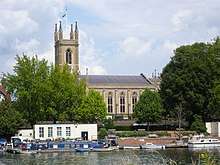
The affiliated churches are:
- Hampton Methodist Church, Hampton
- Hampton Baptist Church, Hampton
- Hampton Hill United Reformed Church, Hampton Hill
- St Theodore's Roman Catholic Church, Hampton
- St Francis de Sales, Hampton Hill and Upper Teddington (Roman Catholic)
- All Saints (Church of England), Old Farm Road, Hampton
- St Mary (Church of England), Church Street (by Thames Street) Hampton
- St James' Church, Hampton Hill (Church of England)
Amenities and entertainment
Garrick's Temple hosts a free Sunday afternoon Shakespeare exhibition (14.00–17.00) from early April to 30 October and a series of summer drama, music and exhibitions.[13]
Hampton Youth Project has been an economically and recreationally resourceful youth centre since 1990. Built in a converted coach depot on the Nurserylands Estate it offers a wide programme of activities for those aged 11–19. Parks include borough-sponsored football pitches and tennis courts in the north and west of the district and children's playgrounds there and in Bushy Park and Hampton Village Green in the east and south.
Hampton Station is on the London Waterloo to Shepperton train line.
The Library is in a Georgian building on Thames Street with a double blue plaque to two former residents, the singer John Beard and William Ewart MP, the Politician behind the Public Libraries Act 1850.
Economy
Thames Water's fresh water operations provide a source of local employment. A group of 17 offices and storage premises including warehouse units, which were built in 2008, are in the south-west of the town.[14]
Hampton Water Treatment Works (WTW)
The large operational Water Treatment Works, owned by Thames Water, is between the Upper Sunbury Road (A308) and the River Thames. It was built in the 1850s after the 1852 Metropolis Water Act[15] made it illegal to take drinking water from the tidal Thames below Teddington Lock because of the amount of sewage in the river. Three companies had established waterworks by 1855 — the Grand Junction Waterworks Company, the Southwark and Vauxhall Waterworks Company, and the West Middlesex Waterworks Company. The site includes old Victorian buildings, filter beds and some larger water storage beds. The site well demonstrates the successful accommodation of nature conservation with operational considerations. The Water Treatment Works is next to the Sunnyside Reservoir and the Stain Hill Reservoirs – sites of Metropolitan Importance for Nature Conservation and contains flower-rich grassland and habitats for water birds.
The extensive areas of open water, especially the Grand Junction Reservoir in the north-west of the site, are used by large numbers of birds, particularly in winter. Most of the site is still in operational use so marginal vegetation, where it occurs, is generally sparse. However, the grasslands surrounding the filter beds and buildings are among the most herb-rich grasslands in the Borough and contain several scarce London species often associated with chalk grassland.[16]
Thames Water completed a five-year modernisation in 1993 and has installed advanced water treatment facilities at the plant to filter out pesticides. Water is supplied via the Staines Aqueduct from the King George VI Reservoir and Staines Reservoirs which receive their input from the River Thames at Hythe End, just above Bell Weir Lock. The aqueduct passes the Water Treatment Works at Kempton Park, which used to be connected to Hampton via the Metropolitan Water Board Railway. The Hampton library is across the road from Hampton Water Works.
Notable inhabitants
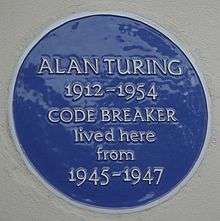
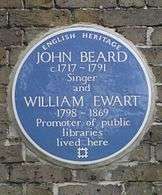
Living people
- Hayley Mills (born 1946), actress, lived on Belgrade Road, in Hampton with her son Crispian Mills (born 1973), singer, songwriter, guitarist and film director[17]
- Bill Milner (born 1995), actor, lives with his family in Hampton[18]
Historical figures
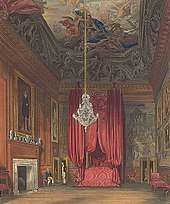
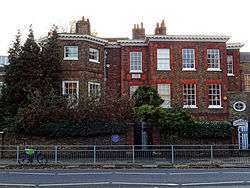
- Queen Anne lived at Hampton Court Palace and continued William and Mary's decoration and completion of its state apartments[19]
- John Beard (c.1717–1791), tenor singer, lived at what is now Hampton Branch Library, Rose Hill, Hampton. The site is marked by a blue plaque[20]
- R D Blackmore (1825–1900), novelist, author of Lorna Doone, lived at 25 Lower Teddington Road, Hampton Wick,[21] whilst he had Gomer House in Teddington (since demolished) built for him
- Lancelot "Capability" Brown (1716–1783), is commemorated with an English Heritage blue plaque at Wilderness House, Hampton Court Palace. He lived there from 1764, when he was appointed Chief Gardener at the palace, until his death in 1783[22]
- Charles I lived at Richmond Palace and at Hampton Court while the plague raged in London. He was held prisoner at Hampton Court in 1647[23]
- Charles II lived at Hampton Court in 1665 to escape the plague in London[23]
- Sir Richard Doll (1912–2005), epidemiologist, was born in Hampton[24]
- William Ewart (1798–1791), promoter of public libraries, lived at what is now Hampton Branch Library, Rose Hill, Hampton. The site is marked by a blue plaque[20]
- David Garrick (1717–1779), actor, lived at Garrick's Villa, Hampton Court Road, Hampton[20]
- George I commissioned the completion of six rooms at Hampton Court Palace to the design of John Vanbrugh[25]
- Harry Hampton VC (1870–1922) was born in Crown Terrace, Richmond and died in Twickenham. He is buried in Richmond Old Cemetery[26]
- Henry VI was born at Hampton Court[23]
- Henry VIII married Catherine Parr – his sixth wife – at Hampton Court[23]
- Norman Cyril Jackson VC (1919–1994) died in Hampton Hill and is buried in Twickenham Cemetery[27]
- Edward Lapidge (1779–1860), who held the post of County Surveyor of Surrey and designed the present Kingston Bridge, was born in Hampton Wick, where he also designed a number of churches[28]
- Mary I and her consort, Philip II of Spain, spent their honeymoon at Hampton Court and Richmond[23]
- Jane Seymour, Henry VIII's third wife, gave birth to the future Edward VI of England at Hampton Court Palace and died two weeks later at Richmond Palace[23]
- John Templeton (1802–1886), opera singer, lived at 114 High Street, Hampton Hill[29]
- Alan Turing (1912–1954) lived at Ivy House (which now has a blue plaque) in Hampton High Street between 1945 and 1947 while working at the National Physical Laboratory in Teddington[30]
- William, Duke of Gloucester, son of the future Queen Anne and Prince George of Hanover, was born at Hampton Court in 1689[23]
- William III and Mary II rebuilt parts of Hampton Court Palace[31]
- Thomas Wolsey, Cardinal Wolsey (1473–1530), lived at Hampton Court[23]
- Sir Christopher Wren (1632–1723), lived at The Old Court House, Hampton Court Green. The site is marked by a blue plaque[20]
- Xenia Alexandrovna of Russia, sister of Tsar Nicholas II, lived at Wilderness Lodge, in the grounds of Hampton Court Palace, from 1937 until her death in 1960[32]
Sport and leisure
- Team sports
Hampton has a Non-League football club Hampton & Richmond Borough F.C. who play at step 2 of Non League football in the National League South at the Beveree Stadium by Station Road, one of the parallel high streets by Hampton railway station.
Rugby Union is well catered for within four miles: Twickenham RFC play in the west of Hampton. Staines RFC and Feltham RFC play at their own Hanworth grounds; London Irish RFC juniors play at Sunbury, London Harlequins RFC play at Twickenham.
- Leisure facilities
The borough supports Hampton Heated Open Air Pool and Gym by Bushy Park and the old High Street, 200m south of the border of Hampton Hill. Private gyms are by Bushy Park and Twickenham Golf Course. A local community association provide social and leisure activities including short mat bowls.
- Watersports
Molesey Boat Club is across the river in Molesey, 500m west of Hampton Court Bridge.
Hampton SC has a clubhouse and boatyard occupying all of Benn's Island. Aquarius SC is by Hampton Court Palace stable yard.
These have rival rowing and sailing clubs on neighbouring reaches of the Thames, and in respect of sailing, on the Queen Mary Reservoir.
In films, other fiction and the media
The 1857 novel "The Three Clerks" by Anthony Trollope is set in Hampton, which was then a village on the western outskirts of London: "There are still, however, some nooks within reach of the metropolis which have not been be-villaged and be-terraced out of all look of rural charm, and the little village of Hampton, with its old-fashioned country inn, and its bright, quiet, grassy river, is one of them..." The area is also featured briefly in two Charles Dickens novels. In Oliver Twist, Oliver and Sykes stop in a public house in Hampton on their way to the planned burglary in Chertsey. In Nicholas Nickleby, Sir Mulberry Hawk and Lord Frederick visit the 'Hampton Races', which refers to a racecourse at 'Moulsey Hurst'. It is also briefly mentioned in The War of the Worlds. The Bell public house in Hampton is mentioned in T S Eliot's Old Possum's Book of Practical Cats. Hampton is also mentioned in humorist Jerome K. Jerome's Three Men in a Boat. In 24: Live Another Day terrorist Margot Al-Harazi's first hideout is stated to be in Hampton.
A murder at the outset of 2001 took place in a spate across a wide suburban area at the hands of Levi Bellfield since which there has been relatively few unprovoked attacks of such a scale in this district.
Demography and housing
| Ward | Detached | Semi-detached | Terraced | Flats and apartments | Caravans/temporary/mobile homes/houseboats | Shared between households[1] |
|---|---|---|---|---|---|---|
| Hampton | 750 | 1,247 | 983 | 1,125 | 66 | 3 |
| Hampton North | 653 | 1,056 | 1,276 | 1,053 | 9 | 39 |
| Fulwell and Hampton Hill (mostly in district) | 423 | 1,062 | 1,349 | 1,390 | 2 | 26 |
| Ward | Population | Households | % Owned outright | % Owned with a loan | hectares[1] |
|---|---|---|---|---|---|
| Hampton | 9,985 | 4,086 | 32 | 36 | 688 |
| Hampton North | 9,387 | 4,455 | 30 | 33 | 195 |
| Fulwell and Hampton Hill (not included in summary) | 10,131 | 4,450 | 30 | 42 | 192 |
Transport
- Roads
In keeping with its lack of high rise buildings, the district has no dual carriageways, its main routes the A308 and A312, have in their busiest sections an additional filter or bus lane.
Bus routes that serve Hampton are the 111, 216, R68 and R70. The 411 and 285 serve Hampton Court and Hampton Hill respectively.[33]
- Rail
The main station is towards the south-west and by the main parades of shops on either side of the line: Hampton; just north of Hampton Hill is Fulwell railway station; both are on the Shepperton Branch Line. Just south of Hampton Court neighbourhood, clustered about the Tudor, Stuart and Georgian Palace and Gardens is Hampton Court railway station on the Hampton Court Branch Line. Hampton Wick railway station is on the Kingston Loop Line. The London terminus for both lines is London Waterloo.
Nearest places
See also
Notes and references
- Notes
- ↑ The latter has the most fluctuating boundaries in the Borough which are arbitrary and that accordingly has been conjoined in the wards system with Fulwell, London.
- References
- 1 2 3 Key Statistics; Quick Statistics: Population Density United Kingdom Census 2011 Office for National Statistics Note: the towns and villages in this borough relatively neatly overlap with a number of wards. Hampton was split in 2001 into a neat three or four ward fit is listed, depending on whether Hampton Hill is included within its definition; the two places have their own amenities but much of these remain 'shared' to a greater or lesser extent. Hampton Wick is a buffered parish incorporated in the 19th century with its own railway station so is treated separately. Retrieved 21 November 2013
- ↑ Office for National Statistics 2001 census Hampton, Hampton Hill, Hampton North (a separate ward of Hampton Hill parish generally considered within Hampton not Hampton Hill) and Hampton Wick. Retrieved 2012-4-11
- ↑ Population in the 19th and early 20th centuries Vision of Britain University of Portsmouth and others. Retrieved 2013-12-19
- ↑ Hampton Vision of Britain University of Portsmouth and others. Retrieved 2013-12-19
- ↑ Hampton UD Vision of Britain University of Portsmouth and others. Retrieved 2013-12-19
- ↑ Pub listings in "Hampton, Middlesex" Dental listings in "Hampton, Middlesex" Places to Rent in "Hampton, Middlesex" Towns guide placing Hampton in Middlesex
- ↑ (Bus) stop info. Transport for London. Retrieved 26 December 2013
- ↑ The Islands Our Hampton. Retrieved 2013-12-26
- ↑ Greater London stops Livebus.org Retrieved 26 December 2013
- ↑ Roy, William (1785). "An Account of the Measurement of a Base on Hounslow-Heath". Philosophical Transactions of the Royal Society of London. 75: 385–480. doi:10.1098/rstl.1785.0024.
- ↑ Top 100 independent senior schools in the UK for 2017
- ↑ Churches Together Around Hampton
- ↑ "Garrick's Temple". Archived from the original on 29 September 2011. Retrieved 23 June 2012.
- ↑ Kempton Gate Retrieved 26 December 2013
- ↑ An Act to make better Provision respecting the Supply of Water to the Metropolis, (15 & 16 Vict. C.84)
- ↑ Mayor of London London Wildweb
- ↑ Rebecca Hardy (17 August 2007). "The Mills Family Show Must Go on!". Daily Mail. Retrieved 10 August 2016.
- ↑ Sally Williams (22 March 2008). "Son of Rambow: ready for action". The Daily Telegraph. London. Retrieved 28 October 2012.
- ↑ John Summerson (1969). Great Palaces. London: Hamlyn Publishing Group Ltd. pp. 12–23. ISBN 0-600-01682-X.
- 1 2 3 4 "Blue Plaques in Richmond upon Thames". Visit Richmond. London Borough of Richmond upon Thames. Retrieved 4 February 2016.
- ↑ "Richard Doddridge Blackmore (1825–1900)". Local History Notes. London Borough of Richmond upon Thames. 9 January 2015. Retrieved 25 August 2017.
- ↑ "Brown, Lancelot 'Capability' (1716–1783)". English Heritage. Retrieved 23 August 2017.
- 1 2 3 4 5 6 7 8 "Royal Richmond timeline". Local history timelines. London Borough of Richmond upon Thames. Retrieved 21 November 2017.
- ↑ Robin McKie (7 July 2002). "Topic of cancer". The Observer. London. Retrieved 6 January 2018.
- ↑ Simon Thurley (2003). Hampton Court: A Social and Architectural History. Yale University Press. p. 255. ISBN 978-0300102239.
- ↑ "Harry Hampton". Victoria Cross holders buried in the borough. London Borough of Richmond upon Thames. 3 August 2009. Retrieved 24 August 2017.
- ↑ "Norman Cyril Jackson". Victoria Cross holders buried in the borough. London Borough of Richmond upon Thames. 3 August 2009. Retrieved 17 November 2017.
- ↑ Thomas Byerly; Reuben Percy; John Timbs (1832). "Chapel of St John the Baptist at Hampton Wick". The Mirror of Literature, Amusement, and Instruction. John Limbird. 19: 376.
- ↑ "John Templeton 1802–1886 Opera singer lived here". Open Plaques. Retrieved 9 October 2012.
- ↑ "Alan Turing: The father of modern computer science". Twickenham Museum. Retrieved 3 November 2012.
- ↑ John Summerson (1969). Great Palaces. London: Hamlyn Publishing Group Ltd. pp. 12–13. ISBN 0-600-01682-X.
- ↑ "Grand Duchess Olga Alexandrovna, discussion and pictures". alexanderpalace.org. Retrieved 26 June 2014.
- ↑ "Main London Bus Routes". London Bus Routes. Retrieved 26 December 2013.
External links


- One Hampton
- Our Hampton
- Hampton Online
- Hampton People's Network
- Hampton Youth Project
- Hampton Water Works
- The 9 am Tuesday Chlorine Warning Siren Test
- The Thames from Hampton Court to Sunbury Lock – Hampton Waterworks
- The Twickenham Museum
